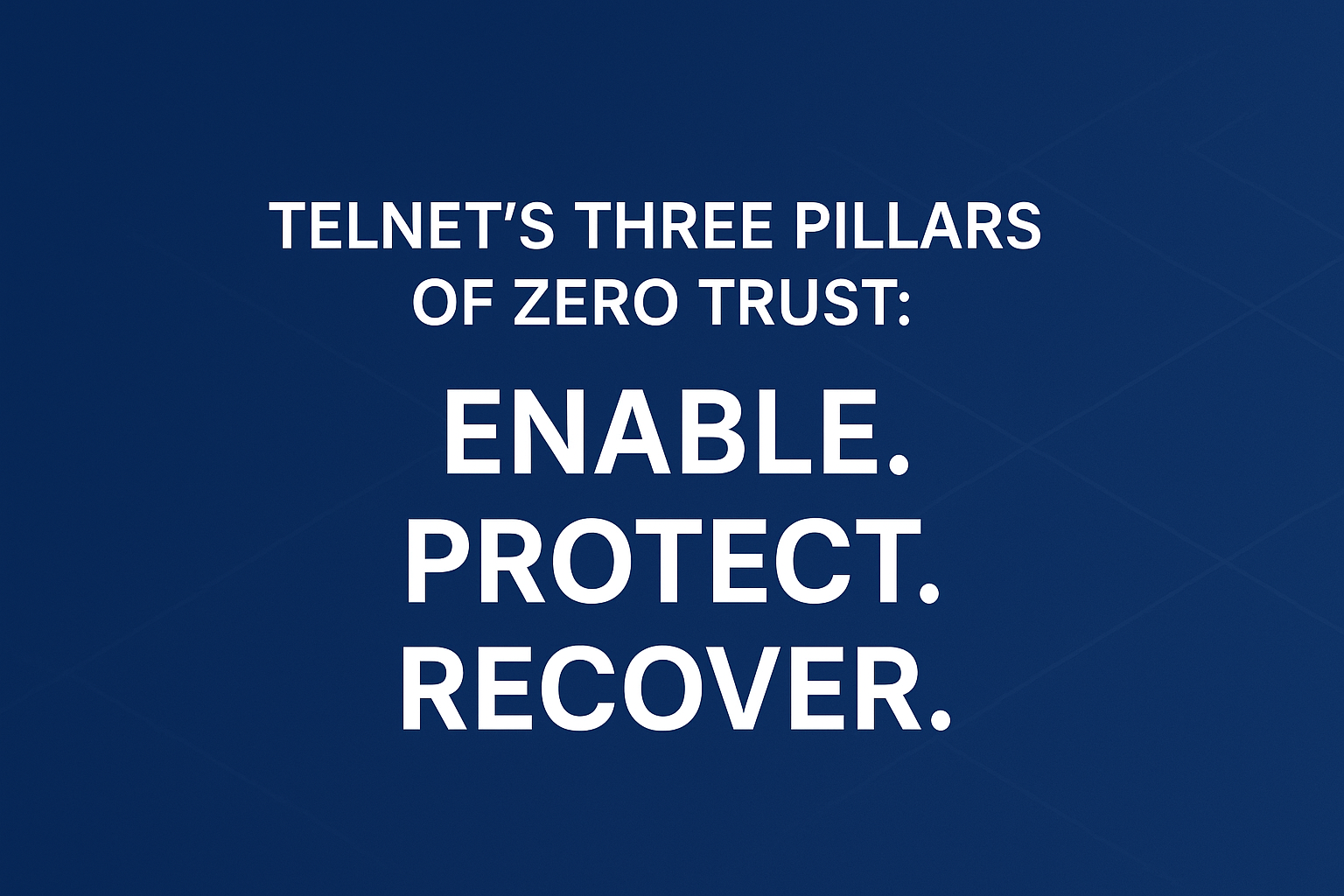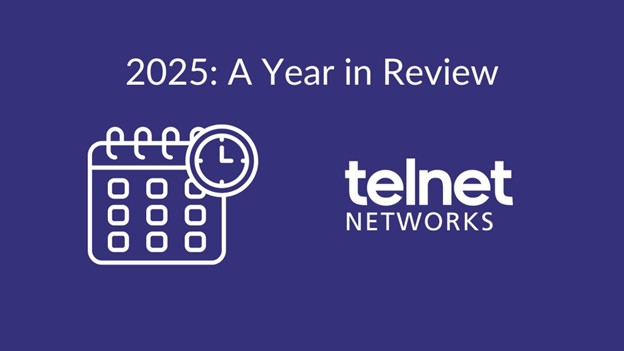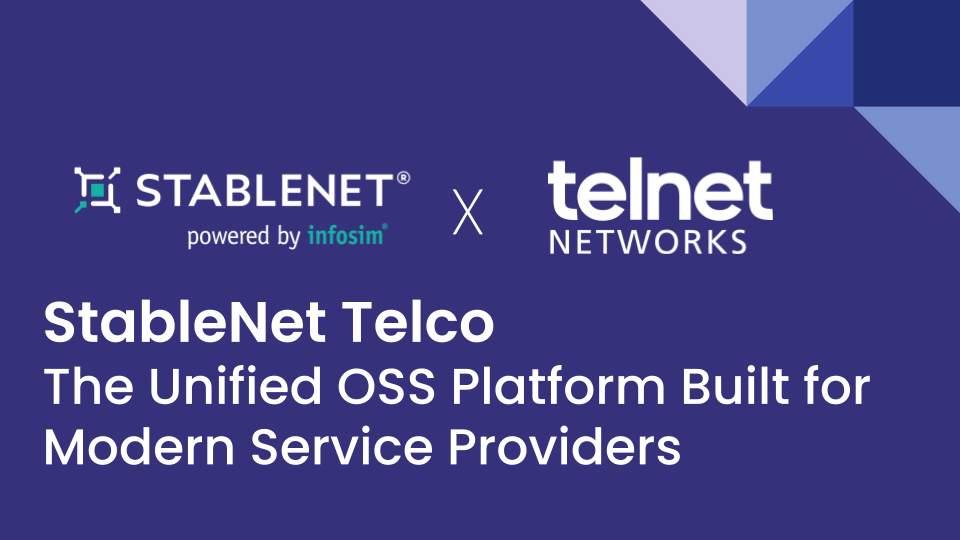Zero Trust has quickly evolved from a niche cybersecurity concept into a foundational strategy for organizations looking to secure increasingly distributed, hybrid, and cloud-connected environments. But despite the widespread adoption of Zero Trust terminology, the path to implementation remains complex—and many organizations still struggle to translate theory into operational practice.
At Telnet Networks, we help organizations across Canada build real-world Zero Trust architectures backed by visibility, endpoint assurance, segmentation, identity controls, and continuous monitoring. Our approach is rooted in the principle that Zero Trust is not a product—it’s a strategy supported by coordinated technology, operational alignment, and ongoing improvement.
We provide a clear, jargon-free explanation of Zero Trust and introduce Telnet Networks’ three-pillar model for Zero Trust enablement: Enable, Protect, and Recover.
What Zero Trust Really Means
“Never trust, always verify” is the classic tagline—but it only scratches the surface.
Zero Trust is a security model built on three core principles:
1. Assume Breach
Organizations must plan as though a compromise has already happened.
Security strategies shift from keeping attackers out to limiting their movement, detecting them quickly, and minimizing damage.
2. Verify Explicitly
Every user, device, application, and data request must be authenticated and continuously validated.
This includes:
- MFA and adaptive authentication
- Device posture checks
- Behavioral analytics
- Location and context-based risk scoring
With stolen credentials involving 86% of breaches, verification cannot stop at the login screen.
3. Least Privilege Access
Provide users only the access they need, for the time they need it, under the conditions appropriate for their role.
This reduces lateral movement and limits insider risk.
Why Zero Trust Is Necessary
Today’s networks no longer have a meaningful perimeter. Cloud adoption, remote work, IoT/OT integration, and SaaS have made traditional “trusted internal, untrusted external” models obsolete.
Attackers have evolved too. AI-powered malware, credential theft, and automated intrusion tools make it easier than ever for threats to bypass traditional defenses.
Organizations need a new default mindset: trust nothing unless continuously verified.
Key Technology Areas That Support Zero Trust
Zero Trust is multi-disciplinary by design. Telnet Networks helps organizations evaluate, integrate, and operationalize the following core building blocks:
Identity & Access Management (IAM)
- MFA, SSO, RBAC
- Continuous authentication
- Context-based and adaptive access controls
Network Segmentation & Micro-Segmentation
- Reduces lateral movement
- Isolates sensitive assets
- Enforces east-west traffic controls
Endpoint Security (EDR/XDR)
- Device posture checks before granting access
- AI-enabled threat detection
- Continuous monitoring for malware and vulnerabilities
Network Visibility & Monitoring
Zero Trust requires deep insight into how traffic moves across the network.
Telnet’s ecosystem includes:
- Network TAPs
- Packet brokers
- Deep Packet Inspection (DPI)
- Network traffic analytics and replay tools
These provide the forensic depth necessary to validate trust, detect anomalies, and respond to threats.
Data Security
- Encryption at rest, in transit, and in use
- Secure key management
- Data access monitoring and anomaly detection
- Backup, resilience, and recovery tooling
The Telnet Networks Zero Trust Model: Enable, Protect, Recover
While Zero Trust frameworks often focus on design principles, Telnet’s approach emphasizes implementability.
Our three-pillar model ensures the underlying data, detection technology, and response capabilities are aligned.
1. ENABLE — Ensure Data Availability for Trust Decisions
Zero Trust relies heavily on timely, accurate telemetry.
Telnet provides the tools that make trustworthy security analytics possible:
- Network TAPs and Packet Brokers for complete packet data
- Traffic aggregation for SIEM, IDS/IPS, NDR, and analytics platforms
- Real-time and historical visibility for investigations
If data is missing or incomplete, Zero Trust cannot function.
2. PROTECT — Identify, Isolate, and Remove Threats
Protection requires active, integrated security controls:
- Endpoint Detection & Response (EDR/XDR)
- Network Detection & Response (NDR)
- SIEM and SOAR integrations
- Identity-driven access enforcement
- Micro-segmentation and least-privilege controls
These tools prevent lateral movement and stop credential-based attacks before they escalate.
3. RECOVER — Prepare for When Breach Happens
No Zero Trust implementation is complete without strong recovery and forensic capabilities.
Telnet supports organizations with:
- Incident response tooling and services
- Network playback and historical reconstruction
- Breach and attack simulation
- Tabletop exercises and readiness assessments
Recovery closes the loop, ensuring organizations understand what occurred—and how to strengthen defenses going forward.
Challenges Organizations Face on the Zero Trust Journey
Zero Trust is powerful, but it isn’t easy. Common challenges include:
Encryption Blind Spots
Encrypted traffic protects privacy but reduces visibility. DPI, decryption zones, and metadata analysis are essential counterbalances.
User Experience Trade-offs
Too many authentication prompts frustrate users; too few create risk.
Adaptive and context-aware IAM is the solution.
AI-Powered Threats
Attackers now use AI to evade detection, generate phishing campaigns, and automate intrusion attempts.
Organizations must counter with AI-driven analytics and anomaly detection.
Lack of a Cohesive Strategy
Zero Trust fails when implemented in silos.
Network, security, cloud, and application teams must collaborate around a unified plan and departments must be aligned on policies, tools, enforcement and training.
Zero Trust Requires a Phased, Holistic Roadmap
Based on Telnet’s experience, successful Zero Trust initiatives share these characteristics:
- A multi-year, phased rollout strategy
- Cross-departmental alignment
- Harmonized access and security policies
- Continuous iteration—not a one-and-done project
Zero Trust is a journey, not an appliance.
How Telnet Networks Helps Organizations Move Forward
As a Canadian leader in network visibility, endpoint protection, and cybersecurity enablement, Telnet Networks brings:
- Over 20 years of enterprise and government experience
- A best-of-breed technology ecosystem
- Strong partnerships with innovative OEMs
- A vendor-agnostic, customer-first consulting approach
Whether building from scratch or strengthening an existing roadmap, Telnet provides the tools, expertise, and guidance needed to translate Zero Trust from theory into operational practice.
Start Your Zero Trust Journey With Telnet
If your organization is evaluating Zero Trust—or needs help advancing an existing initiative—Telnet Networks is ready to help.





